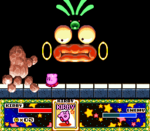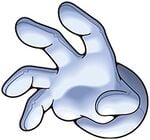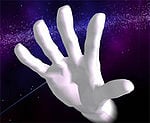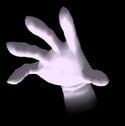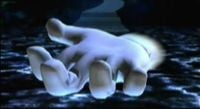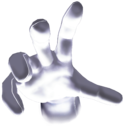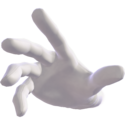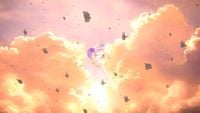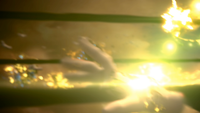Master Hand
- For details in individual games, see Master Hand (SSB), Master Hand (SSBM), Master Hand (SSBB), Master Hand (SSB4), and Master Hand (SSBU).
| Master Hand | |
|---|---|
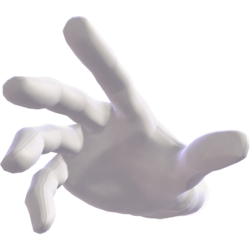 
Render of Master Hand in Super Smash Bros. Ultimate | |
| A boss in | SSB Melee Brawl SSB4 Ultimate |
| Universe | Super Smash Bros. |
| Gender | Male |
| Console of origin | Nintendo 64 |
| English voice actor | Jeff Manning (SSB) Dean Harrington (Melee) Pat Cashman (Brawl) Xander Mobus (SSB4 and Ultimate) |
| Article on WiKirby | Master Hand |
| “ | Bwa-hah-hah-hah-hah! | ” |
| —Master Hand | ||
Master Hand (マスターハンド, Master Hand) is a hand-like entity who acts as the main recurring boss in the Super Smash Bros. universe. He appears at Final Destination as the final boss of the 1P Game in Super Smash Bros. and of Classic Mode in Super Smash Bros. Melee, Super Smash Bros. Brawl, Super Smash Bros. 4, and some fighters' paths in Super Smash Bros. Ultimate. He also plays a large role in Adventure Mode: The Subspace Emissary and Adventure Mode: World of Light. Due to his role as a boss, Master Hand is often unplayable barring hacks, though a glitch that allows the player to play as him exists in Super Smash Bros. Melee. The player must bring his HP down to zero to defeat him. Master Hand's left hand counterpart, Crazy Hand, was introduced in Melee.
Despite appearing in all five games of the series, considerable mystery surrounds the character, due to a lack of sufficient official explanations. However, he is known as the creator of the Super Smash Bros. universe, and in Brawl as the master of the World of Trophies.[1] His trophy info in Brawl implies that he does not use his full power against the fighters, and merely toys with them for his own enjoyment which is further implied in the World of Light mode where in his playable appearance he has more stamina and his attacks being far more powerful than the power of his attacks as a boss. In Super Smash Bros 4, Master Hand is shown to have some connection to Master Core, with the "Swarm" that Master Core comprises appearing from within Master Hand after he has taken enough damage. This link between the two has yet to be elaborated upon in the Smash universe.
Master Hand is playable in Ultimate in a special event battle found in World of Light. Elsewhere and in other games, he is only playable via a glitch in Super Smash Bros. Melee or through hacking.
Master Hand is usually fought on Final Destination, although in Ultimate, Donkey Kong's Classic Mode instead uses the Ω form of New Donk City Hall, Joker's Classic Mode uses the Ω form of Mementos, and Sephiroth's Classic Mode uses the Ω form of Northern Cave.
Origin[edit]
Some of Master Hand's attacks are very similar to those of Wham Bam Rock in Kirby Super Star (Kirby's Fun Pak in the PAL regions).
Wham Bam Rock attacks using its hand, which is made of rocks. Wham Bam Rock and Master Hand share a move where they point their index finger at Kirby like a gun; however, Wham Bam Rock proceeds to make rocks fall, while Master Hand shoots out bullets. Both Wham Bam Rock and Master Hand perform a move that involves "walking" across the stage using their fingers to flick Kirby. Both will also try to grab on to the player and crush them.[2]
In Super Smash Bros.[edit]
![]() In Super Smash Bros., Master Hand is the final boss of the 1P Game. He resides in Final Destination.
In Super Smash Bros., Master Hand is the final boss of the 1P Game. He resides in Final Destination.
He is also seen in the opening movie. He places plush dolls of two characters on a table and positions objects around them. After counting down from three, he snaps his fingers, transforming the objects and table into a stage resembling Peach's Castle, and bringing both of the plush dolls to life.
In Super Smash Bros. Melee[edit]
![]() Super Smash Bros. Melee sees Master Hand reprising his role as a boss in Classic Mode. He is fought in the final battle on Final Destination. Defeating Master Hand once again causes the screen to fade to white as he explodes into the background.
Super Smash Bros. Melee sees Master Hand reprising his role as a boss in Classic Mode. He is fought in the final battle on Final Destination. Defeating Master Hand once again causes the screen to fade to white as he explodes into the background.
Master Hand received a multitude of alterations to his overall fighting style in Melee. He faces only one direction, and his HP and power change with the difficulty. The highest levels of difficulty give him attacks with OHKO potential. Aesthetically, he no longer has a cuff, instead having a wrist that fades into nothingness.
The game also introduced Crazy Hand, Master Hand's left-handed partner. When the two are on the field at the same time, they can perform powerful combination attacks. Crazy Hand appears when set conditions are met. The duo also appear in Event 50: Final Destination Match as boss characters.
Trophy[edit]
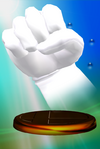
- Master Hand
- The Master Hand awaits anyone who survives the long and difficult road to the Final Destination. This symbolic link between the real world and the imaginary battlefields of Super Smash Bros. Melee is quite a handful in battle, and just because it wears a white glove doesn't mean it fights clean. Get ready to be flicked, swatted, punched, and poked like crazy!
- Super Smash Bros. (4/99)
In Super Smash Bros. Brawl[edit]
Master Hand reprises his role as the final boss of Classic Mode in Super Smash Bros. Brawl, and once again is fought on Final Destination. His attacks are very similar to that of his Melee form with some changes. The amount of HP he has is still dependent on the set difficulty. Crazy Hand also returns in Classic Mode if certain conditions are met.
Role in Adventure Mode: The Subspace Emissary[edit]
Master Hand also appears in The Subspace Emissary, as the one giving orders to Ganondorf, Bowser and Wario. Soon after a Subspace Bomb is used on King Dedede's castle, Ganondorf receives new orders from Master Hand via a video screen.
However, when all of the characters arrive in Subspace, Ganondorf reports to Master Hand after betraying Bowser. When Master Hand reveals himself, however, Ganondorf sees that he has actually been under the control of a powerful being called Tabuu. Tabuu had enslaved Master Hand using chains of light knowing that he could control and use him for recruiting fighters to aid him in his goals.
Ganondorf defiantly attempts to attack Tabuu but is easily knocked back, though his fall breaks the chains of light that Tabuu used to control Master Hand with, thus freeing him. Master Hand subsequently falls into the ground, bleeding from where he was enchained. Master Hand too attempts to strike Tabuu but is beaten with little effort, collapsing once again into the ground and lying motionless in defeat. Whatever happens to Master Hand afterwards is never revealed.
Trophy[edit]
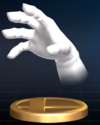
- Master Hand
- A being tied to the link between this world, where trophies fight, and the world beyond. The meaning of his existence is unknown, as are his goals, but he seems to have obtained (and kept hidden) a power that borders on absolute. He also seems to feel a certain joy in challenging chosen warriors who've claimed many victories. He waits even now in Final Destination.
: Super Smash Bros.
: Super Smash Bros. Brawl
In Super Smash Bros. 4[edit]
Master Hand is once again the final boss of Classic Mode in Super Smash Bros. 4. At higher intensities he is fought along with Crazy Hand, and after taking a certain amount of damage, he writhes about in the air before releasing a dark mass named Master Core. In Super Smash Bros. for Wii U, he stars in his own mode named Master Orders.
Unlike the previous games, Master Hand and Crazy Hand share a HP meter. Each of them have new attacks they perform both individually and in conjunction with each other, such as the two tossing energy balls to one another and Crazy Hand opening a rift that sucks in characters that get caught inside.
Trophy[edit]
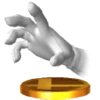
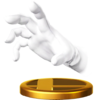
- Master Hand
The mysterious Master Hand is the source of creation in the Smash Bros. universe. He appears in Final Destination when all other rivals are defeated. He fights with a diverse move set and only grows stronger if you make him angry. If you know when to fight and when to dodge, you'll take him down!
: Super Smash Bros. (04/1999)
: Super Smash Bros. for Wii U
Master Hand personifies creation in the Smash Bros. universe. After defeating all your rivals, you face him in Final Destination. He forms various shapes to unleash a wide range of attacks, and on high intensities he'll become speedier, deal more damage and launch you further. To beat him, you'll need to know when to attack and when to hold back.
: Super Smash Bros. (11/1999)
: Super Smash Bros. for Wii U
In Super Smash Bros. Ultimate[edit]
Master Hand returns as the final boss of several characters' Classic Mode routes, sometimes, along with Crazy Hand. Once again, both have separate health bars. The characters that don't fight him are Mario, Captain Falcon (who fight Giga Bowser), Link, Zelda, Young Link, Toon Link (who fight Ganon), Yoshi, Bowser, Marth, Duck Hunt, Piranha Plant, Hero (who fight Rathalos), Kirby, Rosalina & Luma, Inkling (who fight Marx), Luigi, Pac-Man, Simon, Richter (who fight Dracula), Falco, Ken (who fight only Crazy Hand), Snake, R.O.B., Wolf, Mega Man, Dark Pit, King K. Rool, Min Min (who fight Galleom), Jigglypuff, Bayonetta, Terry, Steve and Kazuya (who don't fight any boss). Additionally, some characters have company fighting both of the Hands: Mewtwo fights along with Pikachu, Chrom along with Robin, Pit along with Dark Pit, Diddy Kong along with Donkey Kong, Ryu along with Ken, Incineroar along with Greninja and Byleth along with Marth, Roy, Ike, Robin and Corrin; thus far, Ice Climbers, Meta Knight, Banjo & Kazooie, Sephiroth, Pyra/Mythra and Sora fight them alone.
Role in Adventure Mode: World of Light[edit]
He also appears in Adventure Mode: World of Light. In the introductory cinematic, an army of many Master Hands is seen approaching the fighters alongside Galeem. The Master Hands unravel to reveal blue glowing energy-like forms within, which are then absorbed by Galeem before he unleashes beams of light that consume the fighters. Master Hand will obstruct the player's path several times in The Light Realm and must be fought before reaching Galeem. Following Galeem's defeat, Dharkon appears, sending his army of Crazy Hands to destroy Master Hands, which instead of exploding in blue energy, they burst in yellow.
Master Hand can be fought twice in the Final Battle Realm, a second time which the actual Master Hand will be freed from Galeem's control, suggesting that at some point Master Hand, just like the fighters, must have been copied too. Upon being freed, Master Hand performs a gesture as if he was looking back and forth, implying he was unaware of what happened up until that point. When both Master and Crazy Hand are freed, they create a giant rift via their Static Discharge joint technique, through which Master Hand enters to defeat 50 false characters as a temporary playable character (the only time in the series that Master Hand is playable without hacking). Succeeding, Master Hand flies out of the crack and the Final Battle Realm changes scenery, after which the message appears: "You've conquered both light and darkness!"
In the True Ending, armies of Master Hands and Crazy Hands disintegrate following Galeem and Dharkon's ultimate defeat.
Spirit[edit]
| No. | Image | Name | Type | Class | Slots | Base |
Max |
Base |
Max |
Base |
Max |
Ability | Series |
|---|---|---|---|---|---|---|---|---|---|---|---|---|---|
| 1,095 | Master Hand | ★★★ | 3 | 2945 | 8861 | 1266 | 3810 | 1679 | 5051 | No Effect | Super Smash Bros. Series |
Playability[edit]
In Melee, the Master Hand glitch, a particular application of the Name Entry glitch, allows a player to control Master Hand. Aside from this, the only other methods of controlling Master Hand are by hacking with a cheating device such as GameShark or Action Replay. Several rumors exist of being able to control Master Hand in other games, particularly the original Super Smash Bros., all of which are false. In Ultimate however, he is now playable legitimately for the first time in the penultimate stage of World of Light.
Names in other languages[edit]
Trivia[edit]
- Master Hand and his counterpart Crazy Hand both share English voice actors with the announcer in each Smash Bros. game to date as well as with Joker in Ultimate.
- Super Smash Bros. 4 is the first installment since the original Super Smash Bros. to show a VS. screen when the player reaches Master Hand in Classic Mode.
- This is also the first time an announcer call is used in-game for Master Hand, as well as Crazy Hand.
- His idle pose consists of him simply clenching his fist. However, in all games except Super Smash Bros., this is not seen in normal gameplay due to the AI not allowing enough time between his attacks. It can be seen by using the Master Hand glitch in Melee, or using Boss control codes in Boss Battles mode in Brawl.
- However, in Super Smash Bros. 4, there is a chance that Master Hand will not attack for a while due to Crazy Hand attacking by himself, resulting in him doing the idle pose.
- Melee and Brawl are the only games in the series where Master Hand does not have his own theme song.
- In Brawl, however, Master Hand's battle music is slightly altered from the Final Destination theme in that it skips the short intro at the beginning of the song and goes straight to the lyrics.
- Ultimate is the first game in the Smash series to have Master Hand playable through normal means.
- 64 and Ultimate are the only games in the series in which Master Hand moves around completely freely during the fight, rather than staying in the right side of the screen.
- Ultimate is also the very first game where Master Hand can be stunned and incapacitated during battle.
- In addition, Ultimate is the very first game where Master Hand can be legitimately fought on a stage that isn't Final Destination (In Donkey Kong's Classic Mode, he is instead fought on the Ω form of New Donk City Hall, in Joker's Classic Mode route, he is fought in the Ω form of Mementos, and in Sephiroth's Classic Mode, he is fought on the Ω form of Northern Cave). However, all these stages are a variation of Final Destination.
- An enemy named Uja appears in some levels of Kirby Squeak Squad; it appears to be a swarm of insects taking a form that closely resembles Master Hand's sprite in Amazing Mirror. However, it is made of small, black particles similar to Master Core.
- Master Hand is the only boss to appear in every game.
See also[edit]
References[edit]
- ^ Masahiro Sakurai (10th April, 2008). Mysteries of The Subspace Emissary (text). Smash Bros. DOJO!!. Retrieved on 24th June, 2011. “Master Hand is the master of our world.”
- ^ CrappyCaptureDevice (3rd February, 2008). Master Hand's Moves - History Behind Super Smash Bros. Melee (video). YouTube. Retrieved on 24th June, 2011. “Shows where a few of the Master Hand's moves come from.”
| Bosses | |
|---|---|
| Super Smash Bros. | Master Hand · Metal Mario · Giant Donkey Kong · Fighting Polygon Team |
| Melee | Master Hand · Crazy Hand · Giga Bowser · Fighting Wire Frames (Male · Female) |
| Brawl | Master Hand · Crazy Hand · Petey Piranha · Rayquaza · Porky · Galleom · Ridley · Duon · Meta Ridley · Tabuu · Fighting Alloy Team (Red · Blue · Yellow · Green) · False characters |
| Smash 4 | Master Hand · Crazy Hand · Master Core · Fighting Mii Team |
| Ultimate | Master Hand · Crazy Hand · Rathalos · Galleom · Giga Bowser · Galeem · Dharkon · Dracula · Ganon · Marx · Fighting Mii Team · False characters |
